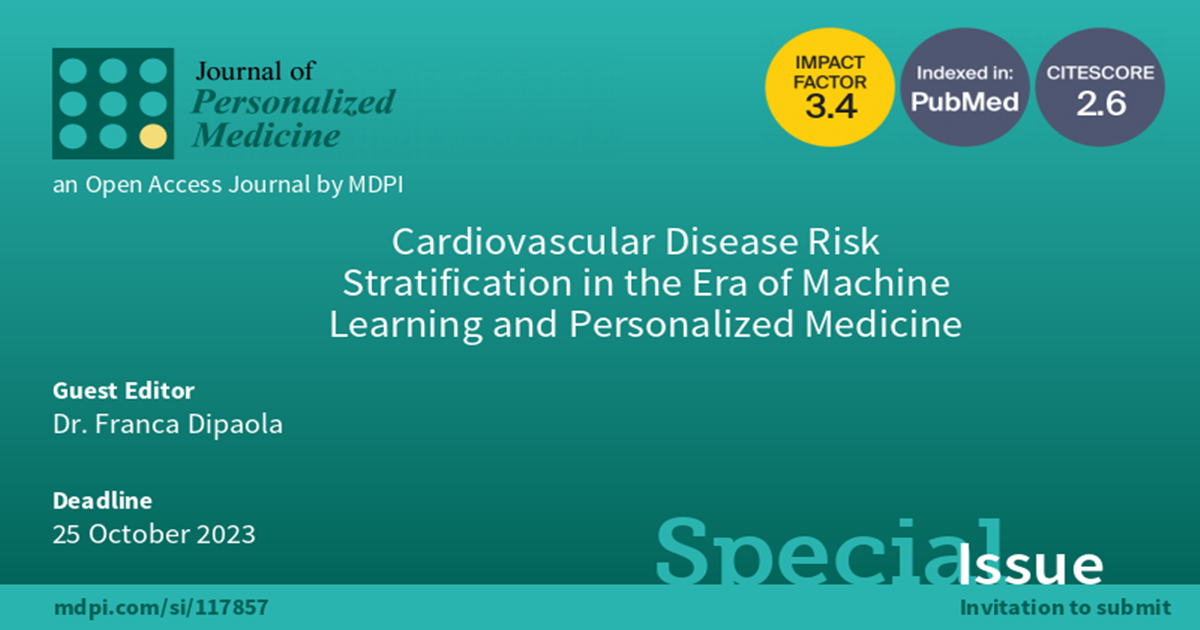Cardiovascular Disease Risk Stratification in the Era of Machine Learning and Personalized Medicine
A special issue of Journal of Personalized Medicine (ISSN 2075-4426). This special issue belongs to the section "Epidemiology".
Deadline for manuscript submissions: closed (25 October 2023) | Viewed by 12020

Special Issue Editor
2. Department of Biomedical Sciences, Humanitas University, Pieve Emanuele, 20090 Milan, Italy
Interests: syncope; risk stratification; cardiovascular autonomic disorders; machine learning; evidence-based medicine
Special Issues, Collections and Topics in MDPI journals
Special Issue Information
Dear Colleagues,
Machine learning (ML) has been promisingly applied in cardiovascular medicine in recent years, both for disease diagnosis and in prognosis prediction.
Compared with traditional statistical techniques, ML algorithms can analyze a larger number of variables by performing greater numbers of mathematical operations and better define complex relationships between risk factors and outcomes of interest, strengthening the predictive process.
Furthermore, the possibility to automatically extract and classify prognostic determinants from large patient populations could generate significant progress in individual risk stratification, thus promoting the optimization of patients’ diagnostic/therapeutic workup and personalization of care.
The extraction and integration of data from various possible sources (clinical measurements and observations, biological -omics, experimental results, wearable devices) make cardiovascular disease particularly suitable for the application of ML techniques.
However, at present, the lack of generalizability, reproducibility, and standardized methodologies for developing and validating ML-based prognostic models reduces the quality of the available evidence and limits their implementation in clinical practice.
The aim of the present Special Issue is to collect original research articles and reviews that will provide updates and future perspectives regarding the application and implementation of ML to the risk stratification of patients suffering from cardiovascular disease.
Dr. Franca Dipaola
Guest Editor
Manuscript Submission Information
Manuscripts should be submitted online at www.mdpi.com by registering and logging in to this website. Once you are registered, click here to go to the submission form. Manuscripts can be submitted until the deadline. All submissions that pass pre-check are peer-reviewed. Accepted papers will be published continuously in the journal (as soon as accepted) and will be listed together on the special issue website. Research articles, review articles as well as short communications are invited. For planned papers, a title and short abstract (about 100 words) can be sent to the Editorial Office for announcement on this website.
Submitted manuscripts should not have been published previously, nor be under consideration for publication elsewhere (except conference proceedings papers). All manuscripts are thoroughly refereed through a single-blind peer-review process. A guide for authors and other relevant information for submission of manuscripts is available on the Instructions for Authors page. Journal of Personalized Medicine is an international peer-reviewed open access monthly journal published by MDPI.
Please visit the Instructions for Authors page before submitting a manuscript. The Article Processing Charge (APC) for publication in this open access journal is 2600 CHF (Swiss Francs). Submitted papers should be well formatted and use good English. Authors may use MDPI's English editing service prior to publication or during author revisions.
Keywords
- coronary artery disease
- heart failure
- arrhythmias
- stroke
- syncope
- electrocardiography
- echocardiography
- prognosis
- precision medicine
- machine learning
Benefits of Publishing in a Special Issue
- Ease of navigation: Grouping papers by topic helps scholars navigate broad scope journals more efficiently.
- Greater discoverability: Special Issues support the reach and impact of scientific research. Articles in Special Issues are more discoverable and cited more frequently.
- Expansion of research network: Special Issues facilitate connections among authors, fostering scientific collaborations.
- External promotion: Articles in Special Issues are often promoted through the journal's social media, increasing their visibility.
- e-Book format: Special Issues with more than 10 articles can be published as dedicated e-books, ensuring wide and rapid dissemination.
Further information on MDPI's Special Issue polices can be found here.






